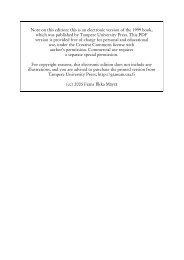Avaa tiedosto - TamPub - Tampereen yliopisto
Avaa tiedosto - TamPub - Tampereen yliopisto
Avaa tiedosto - TamPub - Tampereen yliopisto
Create successful ePaper yourself
Turn your PDF publications into a flip-book with our unique Google optimized e-Paper software.
21 of these, occurred violence, allegedly occurred violence or threats of violence affected<br />
the decision, and 26 in turn bring forth that occurred violence, allegedly occurred<br />
violence or threats of violence did not have an impact on the judge’s decision.<br />
Among the grounds for decisions I distinguished different kinds of ways of explaining<br />
how the impact of violence assessed as having occurred on judges’ decisions is admitted<br />
or denied. When occurred violence is said to have had an impact on the decision,<br />
the most used explanation clearly was that its occurrence reveals the quarrelsome relationship<br />
between parents and thus prevents joint custody. The fear that mothers have for<br />
fathers is used as grounds for both awarding sole custody to mothers and supervised visits<br />
between children and their fathers. The impact of violence on decisions over visits is<br />
justified in other ways as well. Unsupervised visits can be expressed to pose a risk to<br />
children, and children’s fear can be described as well as anger towards the parent having<br />
behaved violently. When violence is not a decisive factor, the most used explanations<br />
are that violence has not been used against children and that it is in past. In the written<br />
grounds, violence is also defined as an issue related to parents’ intimate relationship,<br />
which is not connected to the assessment of parenthood. In addition, the texts include<br />
mentions of how mild the occurred violence was and how riskless the threats were.<br />
When violence is said to have an effect on the final decisions, the perpetrator in<br />
most cases is the father of the family. This is hardly surprising because the cases show<br />
that most particularly fathers are alleged of being violent and more solid evidence has<br />
been presented of it. Among the texts are also written grounds which imply that also<br />
mothers’ violent behaviour has affected the decision of the court. When the significance<br />
of violence is denied, the ways in which this is explained are common to how violent<br />
behaviour displayed by both mothers and fathers is dealt with. This reveals that dealing<br />
with violence is not always organized clearly according to the gender of the perpetrator.<br />
Of the written grounds for the decisions, I identified three different violence discourses.<br />
By the interaction discourse I refer to how violence in the family is interpreted<br />
to be about unsuccessful interaction and about a difficult intimate relationship. The interaction<br />
discourse has an indisputably visible position in the data. It is used to weigh<br />
the validity of the allegation of violence and the significance of used violence. Through<br />
it the impact of violence on the decision can be both admitted and denied. In addition to<br />
intimate partner violence, the interaction discourse concerns also violence against children.<br />
Violence can, for example, be interpreted to mean difficulties in getting along with<br />
children. Suspicion of violence against children can also be denied on the grounds that<br />
the parent-child interaction has been observed and found to be good.<br />
265














